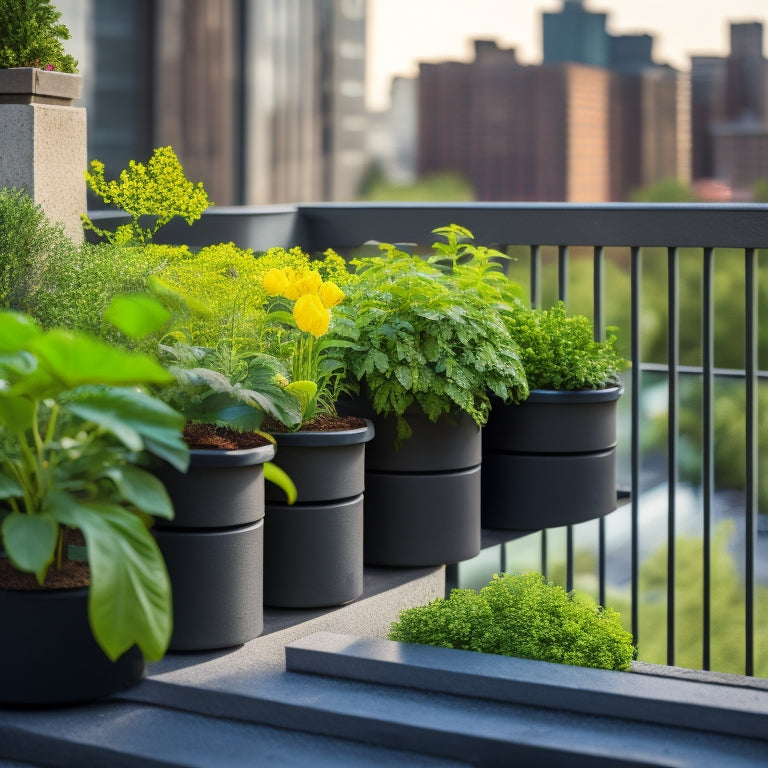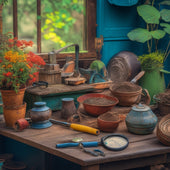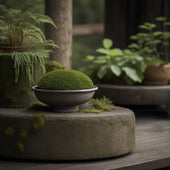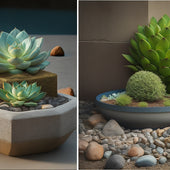
Optimal Cinder Block Planter Size for Small Spaces
Share
You're seeking the perfect cinder block planter size to maximize your small garden space, and it all begins with calculating the ideal dimensions that balance plant growth, sunlight, and visual appeal. Consider the depth: 6-8 inches is a minimum, but deep-rooted plants need more. Width and length are essential too - longer planters fit more plants, while wider ones provide more soil volume. Height-wise, 6-8 inches promotes healthy root growth, but taller planters support maximum vertical growth. By balancing these factors, you'll create a thriving small space garden that's both functional and visually stunning, and there's even more to discover.
Key Takeaways
• Consider the garden's layout, obstacles, and terrain when measuring the space for the planter to ensure optimal placement.
• A minimum depth of 6-8 inches is recommended, but adjust based on plant type, with deep-rooted plants requiring more depth.
• Choose a rectangular planter over a square one for space efficiency, and consider the height for air circulation, sunlight, and visual appeal.
• Plant spacing of 12-18 inches apart allows for air circulation, and consider plant growth patterns for optimal arrangement and visual balance.
• Select a planter size that balances space efficiency, weight distribution, drainage needs, and aesthetic appeal to create a thriving small-space garden.
Measuring Small Garden Spaces
How do you accurately measure the dimensions of your small garden space to guarantee a harmonious fit for your cinder block planter, considering obstacles like pipes, corners, and existing plantings?
Start by mapping out your garden layout, taking note of any fixed features that can't be moved. Use a tape measure or string to record the length and width of your space, as well as the distance between any obstacles. Don't forget to account for any sloping or uneven terrain that could affect your planter's placement.
In urban gardening, where space is often limited, precise measurement is essential.
Consider the mature size of the plants you want to feature in your planter and leave enough room for growth. Make note of any areas that receive full sun, partial shade, or are prone to waterlogging.
By taking the time to thoroughly measure your space, you'll be able to choose the perfect cinder block planter size, ensuring a beautiful and functional addition to your small garden.
With careful planning, you'll be able to maximize your space and create a thriving oasis.
Cinder Block Planter Depth Matters
When selecting a cinder block planter, its depth plays a vital role in accommodating the root systems of your chosen plants. A minimum of 6-8 inches is typically recommended to provide sufficient room for growth.
You'll want to take into account the plant root considerations, as some plants have deeper roots than others. For instance, tomatoes and cucumbers have extensive root systems, requiring more depth to thrive. On the other hand, herbs and succulents have shorter roots, making them suitable for shallower planters.
Adequate depth also guarantees proper drainage solutions. You don't want waterlogged soil, which can lead to root rot and other problems. A deeper planter allows for better water circulation, reducing the risk of water accumulation.
Additionally, you can add a layer of gravel or broken pottery at the bottom of the planter to facilitate drainage. By choosing the right depth for your cinder block planter, you'll be able to create a healthy environment for your plants to flourish.
Width and Length Considerations
You'll next need to contemplate the width and length of your cinder block planter, as these dimensions will determine the overall volume of soil available to your plants and influence the layout of your garden design.
When deciding on the ideal width and length, consider the space constraints of your small area and the mature size of the plants you'll be growing.
Here are some key considerations to keep in mind:
-
A longer planter allows for more plants to be spaced out, while a wider planter provides more soil volume for each plant.
-
A rectangular planter shape can be more space-efficient than a square one, especially when placed against a wall or in a corner.
-
Standard cinder block dimensions are 8 inches wide, 8 inches tall, and 16 inches long, but you can customize your planter by using blocks of different sizes or arranging them in a unique pattern.
Height for Optimal Growth
Now that you've determined the ideal width and length for your cinder block planter, it's time to evaluate the height that will optimize plant growth.
You'll want to balance space-saving height options with the need to accommodate maximum vertical growth.
Space-Saving Height Options
By limiting the planter's height to 6-8 inches, you can promote healthy root growth while maximizing vertical space in compact areas. This range allows for a balance between soil depth and vertical gardening possibilities, making it ideal for small spaces.
Here are some benefits of this height range:
-
Compact footprint: With a shorter planter, you can fit more plants in a smaller area, perfect for balconies, patios, or rooftop gardens.
-
Cinder block aesthetics: The low profile of the planter complements the industrial look of cinder blocks, creating a visually appealing contrast.
-
Easy maintenance: Plants are easily accessible, making it simpler to water, prune, and harvest, even in tight spaces.
Maximum Vertical Growth
As you balance compact footprint with plant growth, consider a planter height that accommodates the mature size of your chosen plants, typically ranging from 12 to 24 inches, to support maximum vertical growth. This range allows plants to stretch upward, promoting healthy root development and ideal plant nutrition. When plants have ample vertical space, they can absorb nutrients more efficiently, resulting in stronger, healthier stems and foliage.
Taller planters also encourage air circulation and sunlight penetration, further supporting plant growth. For example, plants like tomatoes and peas thrive in 18- to 24-inch planters, where they can grow upward and outward without becoming too leggy or weak.
By providing the right amount of vertical space, you can control the direction of growth, guiding your plants to reach their full potential. With a well-designed planter, you'll be able to enjoy a bountiful harvest and admire the beauty of your thriving plants.
Plant Spacing and Arrangement
You'll want to space your plants 12-18 inches apart, depending on their mature size, to guarantee good air circulation and prevent overcrowding in your cinder block planter. This spacing allows for proper growth and development of your plants, ensuring they receive sufficient sunlight, water, and nutrients.
When arranging your plants, consider their growth patterns and types.
For instance:
-
Vining plants like cucumbers or peas can be trained to climb up a trellis or the cinder block walls, maximizing vertical space.
-
Bushy plants like tomatoes or peppers require more horizontal space to spread out, but can be pruned to maintain a compact shape.
-
Tall, upright plants like sunflowers or zinnias can be placed towards the back of the planter, providing a natural backdrop for smaller plants.
Visual Balance and Aesthetics
As you design your cinder block planter, you'll want to contemplate the visual balance and aesthetics to create a visually appealing arrangement.
You can achieve this by incorporating symmetry in your design, which will create a sense of order and harmony.
Symmetry in Design
When designing your cinder block planter, achieving symmetry is essential, since it creates visual balance and aesthetically pleasing compositions that draw the eye to the center.
Symmetry is a fundamental design principle that contributes to the overall harmony of your planter. By incorporating symmetrical elements, you'll create a sense of order and stability, making your planter a focal point in your small space.
Here are some ways to achieve symmetry in your cinder block planter design:
-
Mirror Imagery: Place identical plants or decorative elements on either side of the planter's center axis to create a sense of reflection.
-
Central Focal Point: Designate a central element, such as a statement plant or decorative feature, to draw the eye to the center of the planter.
-
Balanced Composition: Distribute visual weight evenly throughout the planter by balancing large or dark elements with smaller or lighter ones.
Color Scheme Harmony
To create visual balance and aesthetic appeal in your cinder block planter, select a color scheme that harmonizes with the surrounding environment and echoes the hues of the plants and decorative elements within.
When choosing your color palette, consider the following principles to guarantee a harmonious blend:
| Color Principle | Description |
| Monochromatic | Use different shades of a single color to create a cohesive look. |
| Complementary | Pair contrasting hues to create visual interest and energy. |
| Analogous | Select colors that are next to each other on the color wheel for a soothing palette. |
| Triadic | Combine three colors equally spaced from each other on the color wheel for a balanced look. |
| Neutral Background | Use a neutral color as the background to let your plants and decorative elements take center stage. |
Frequently Asked Questions
Can I Use Old or Recycled Cinder Blocks for My Planter?
You're considering repurposing old or recycled cinder blocks for your planter. That's a great idea!
Cinder block durability is a major advantage, and using recycled materials reduces waste. Just verify the blocks are clean and free of debris.
Inspect them for cracks or damage that could compromise their structure. If they're in good condition, you can give them new life in your planter, adding a touch of industrial chic to your space.
How Often Should I Water Plants in Cinder Block Planters?
Frequent, fleeting flushes are fundamental for flourishing flora in cinder block planters.
You'll want to water when the top 1-2 inches of soil feel dry to the touch, usually every 2-3 days in warm weather.
Cinder blocks' moderate moisture retention means you'll need to strike a balance between hydration and drainage.
Avoid overwatering, which can lead to root rot and other issues.
Monitor your plants' responses to adjust your watering frequency for ideal growth.
Will Cinder Blocks Affect the Ph Level of My Soil?
You're right to wonder if cinder blocks will affect your soil's pH level.
Here's the deal: cinder blocks are generally inert, so they won't drastically alter your soil's pH. However, their high pH level can slightly raise your soil's pH over time.
To mitigate this, guarantee good soil drainage by adding a layer of perlite or vermiculite to your mix. This will prevent waterlogged soil and minimize any potential pH impact.
With proper cinder block safety and soil management, you'll be all set.
Can I Paint or Stain Cinder Blocks for a Decorative Look?
Imagine a vibrant patio scene with a cinder block planter, transformed from drab to fab with a bold, fire-engine red stain.
You can achieve this look by painting or staining your cinder blocks! To get started, clean and prime the blocks, then apply a decorative finish like acrylic latex paint or a concrete stain.
With countless color options, you'll find the perfect hue to match your outdoor aesthetic.
Are Cinder Block Planters Suitable for Indoor Gardening?
You're wondering if cinder block planters are suitable for indoor gardening. Absolutely! They're a great choice, offering several benefits for indoor gardening.
Cinder block materials are durable, low-maintenance, and can thrive in indoor conditions. They allow for excellent drainage, aeration, and root growth, making them ideal for plants that require well-oxygenated soil.
Plus, they can add a touch of industrial chic to your indoor space. With proper care, your cinder block planter will flourish, bringing a slice of greenery to your indoor oasis.
Conclusion
As you step back to admire your compact cinder block planter, envision a thriving oasis in the midst of a bustling cityscape.
With carefully calculated dimensions, your small space is transformed into a lush haven. The ideal planter size, precision-placed plants, and thoughtful arrangement create a visual symphony, harmonizing form and function.
The result? A miniature Eden that's both beautiful and bountiful, where every inch is maximized for growth and serenity.
Related Posts
-

5 Must-Knows for Buying Used Tools for Planters
When buying used tools for planters, you're investing in the reliability and performance of your operations, so it's ...
-

5 Must-Knows for Buying Used Tools for Planters
When buying used tools for planters, you're investing in the reliability and performance of your operations, so it's ...
-

5 Must-Knows for Buying Used Tools for Planters
When buying used tools for planters, you're investing in the reliability and performance of your operations, so it's ...
-

5 Must-Knows for Buying Used Tools for Planters
When buying used tools for planters, you're investing in the reliability and performance of your operations, so it's ...
-

5 Must-Knows for Buying Used Tools for Planters
When buying used tools for planters, you're investing in the reliability and performance of your operations, so it's ...
-

5 Must-Knows for Buying Used Tools for Planters
When buying used tools for planters, you're investing in the reliability and performance of your operations, so it's ...
-

5 Must-Knows for Buying Used Tools for Planters
When buying used tools for planters, you're investing in the reliability and performance of your operations, so it's ...
-

5 Must-Knows for Buying Used Tools for Planters
When buying used tools for planters, you're investing in the reliability and performance of your operations, so it's ...
-

5 Must-Knows for Buying Used Tools for Planters
When buying used tools for planters, you're investing in the reliability and performance of your operations, so it's ...
-

5 Must-Knows for Buying Used Tools for Planters
When buying used tools for planters, you're investing in the reliability and performance of your operations, so it's ...
-

5 Must-Knows for Buying Used Tools for Planters
When buying used tools for planters, you're investing in the reliability and performance of your operations, so it's ...
-

5 Must-Knows for Buying Used Tools for Planters
When buying used tools for planters, you're investing in the reliability and performance of your operations, so it's ...
-

5 Must-Knows for Buying Used Tools for Planters
When buying used tools for planters, you're investing in the reliability and performance of your operations, so it's ...
-

5 Must-Knows for Buying Used Tools for Planters
When buying used tools for planters, you're investing in the reliability and performance of your operations, so it's ...
-

5 Must-Knows for Buying Used Tools for Planters
When buying used tools for planters, you're investing in the reliability and performance of your operations, so it's ...
-

5 Must-Knows for Buying Used Tools for Planters
When buying used tools for planters, you're investing in the reliability and performance of your operations, so it's ...
-

5 Must-Knows for Buying Used Tools for Planters
When buying used tools for planters, you're investing in the reliability and performance of your operations, so it's ...
-

5 Must-Knows for Buying Used Tools for Planters
When buying used tools for planters, you're investing in the reliability and performance of your operations, so it's ...
-

5 Must-Knows for Buying Used Tools for Planters
When buying used tools for planters, you're investing in the reliability and performance of your operations, so it's ...
-

5 Must-Knows for Buying Used Tools for Planters
When buying used tools for planters, you're investing in the reliability and performance of your operations, so it's ...
-

How Much Do Concrete Planters Weigh
When creating a concrete planter, you'll need to take into account the weight implications of your design. The type a...
-

How Much Do Concrete Planters Weigh
When creating a concrete planter, you'll need to take into account the weight implications of your design. The type a...
-

How Much Do Concrete Planters Weigh
When creating a concrete planter, you'll need to take into account the weight implications of your design. The type a...
-

How Much Do Concrete Planters Weigh
When creating a concrete planter, you'll need to take into account the weight implications of your design. The type a...
-

How Much Do Concrete Planters Weigh
When creating a concrete planter, you'll need to take into account the weight implications of your design. The type a...
-

How Much Do Concrete Planters Weigh
When creating a concrete planter, you'll need to take into account the weight implications of your design. The type a...
-

How Much Do Concrete Planters Weigh
When creating a concrete planter, you'll need to take into account the weight implications of your design. The type a...
-

How Much Do Concrete Planters Weigh
When creating a concrete planter, you'll need to take into account the weight implications of your design. The type a...
-

How Much Do Concrete Planters Weigh
When creating a concrete planter, you'll need to take into account the weight implications of your design. The type a...
-

How Much Do Concrete Planters Weigh
When creating a concrete planter, you'll need to take into account the weight implications of your design. The type a...
-

How Much Do Concrete Planters Weigh
When creating a concrete planter, you'll need to take into account the weight implications of your design. The type a...
-

How Much Do Concrete Planters Weigh
When creating a concrete planter, you'll need to take into account the weight implications of your design. The type a...
-

How Much Do Concrete Planters Weigh
When creating a concrete planter, you'll need to take into account the weight implications of your design. The type a...
-

How Much Do Concrete Planters Weigh
When creating a concrete planter, you'll need to take into account the weight implications of your design. The type a...
-

How Much Do Concrete Planters Weigh
When creating a concrete planter, you'll need to take into account the weight implications of your design. The type a...
-

How Much Do Concrete Planters Weigh
When creating a concrete planter, you'll need to take into account the weight implications of your design. The type a...
-

How Much Do Concrete Planters Weigh
When creating a concrete planter, you'll need to take into account the weight implications of your design. The type a...
-

How Much Do Concrete Planters Weigh
When creating a concrete planter, you'll need to take into account the weight implications of your design. The type a...
-

How Much Do Concrete Planters Weigh
When creating a concrete planter, you'll need to take into account the weight implications of your design. The type a...
-

How Much Do Concrete Planters Weigh
When creating a concrete planter, you'll need to take into account the weight implications of your design. The type a...
-

How Much Do Concrete Planters Weigh
When creating a concrete planter, you'll need to take into account the weight implications of your design. The type a...
-

How Much Do Concrete Planters Weigh
When creating a concrete planter, you'll need to take into account the weight implications of your design. The type a...
-

How Much Do Concrete Planters Weigh
When creating a concrete planter, you'll need to take into account the weight implications of your design. The type a...
-

How Much Do Concrete Planters Weigh
When creating a concrete planter, you'll need to take into account the weight implications of your design. The type a...
-

How Much Do Concrete Planters Weigh
When creating a concrete planter, you'll need to take into account the weight implications of your design. The type a...
-

How Much Do Concrete Planters Weigh
When creating a concrete planter, you'll need to take into account the weight implications of your design. The type a...
-

How Much Do Concrete Planters Weigh
When creating a concrete planter, you'll need to take into account the weight implications of your design. The type a...
-

How Much Do Concrete Planters Weigh
When creating a concrete planter, you'll need to take into account the weight implications of your design. The type a...
-

How Much Do Concrete Planters Weigh
When creating a concrete planter, you'll need to take into account the weight implications of your design. The type a...
-

Succulent-Friendly Drainage Solutions for Block Planters
You can create a succulent-friendly drainage system in your cinder block planters by drilling holes in the bottom of ...
-

Succulent-Friendly Drainage Solutions for Block Planters
You can create a succulent-friendly drainage system in your cinder block planters by drilling holes in the bottom of ...
-

Succulent-Friendly Drainage Solutions for Block Planters
You can create a succulent-friendly drainage system in your cinder block planters by drilling holes in the bottom of ...
-

Succulent-Friendly Drainage Solutions for Block Planters
You can create a succulent-friendly drainage system in your cinder block planters by drilling holes in the bottom of ...
-

Succulent-Friendly Drainage Solutions for Block Planters
You can create a succulent-friendly drainage system in your cinder block planters by drilling holes in the bottom of ...
-

Succulent-Friendly Drainage Solutions for Block Planters
You can create a succulent-friendly drainage system in your cinder block planters by drilling holes in the bottom of ...
-

Succulent-Friendly Drainage Solutions for Block Planters
You can create a succulent-friendly drainage system in your cinder block planters by drilling holes in the bottom of ...
-

Succulent-Friendly Drainage Solutions for Block Planters
You can create a succulent-friendly drainage system in your cinder block planters by drilling holes in the bottom of ...
-

Succulent-Friendly Drainage Solutions for Block Planters
You can create a succulent-friendly drainage system in your cinder block planters by drilling holes in the bottom of ...
-

Succulent-Friendly Drainage Solutions for Block Planters
You can create a succulent-friendly drainage system in your cinder block planters by drilling holes in the bottom of ...
-

Succulent-Friendly Drainage Solutions for Block Planters
You can create a succulent-friendly drainage system in your cinder block planters by drilling holes in the bottom of ...
-

Succulent-Friendly Drainage Solutions for Block Planters
You can create a succulent-friendly drainage system in your cinder block planters by drilling holes in the bottom of ...
-

Succulent-Friendly Drainage Solutions for Block Planters
You can create a succulent-friendly drainage system in your cinder block planters by drilling holes in the bottom of ...
-

Succulent-Friendly Drainage Solutions for Block Planters
You can create a succulent-friendly drainage system in your cinder block planters by drilling holes in the bottom of ...
-

Succulent-Friendly Drainage Solutions for Block Planters
You can create a succulent-friendly drainage system in your cinder block planters by drilling holes in the bottom of ...


